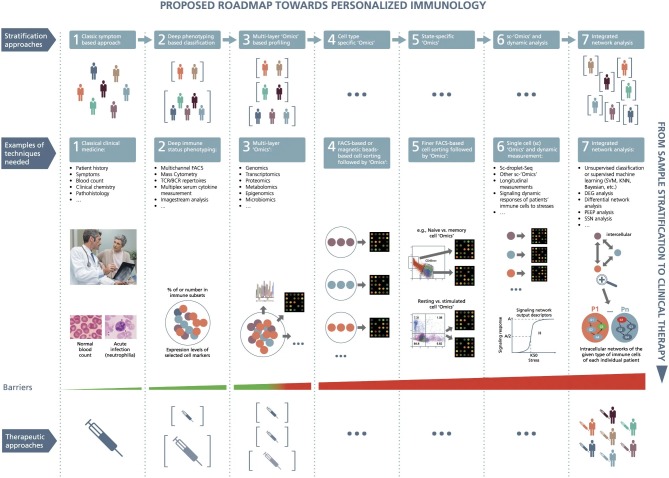Figure 4.
A roadmap proposed toward personalized immunology. There exist both horizontal and vertical roadmaps toward personalized immunology. Vertically, to translate sample stratification to clinical therapies, it is necessary to utilize the state-of-the-art “Omics” analysis and network integration approaches to stratify patients into subgroups and then implement personalized therapeutic approaches to treat individual patients, which needs to overcome various types of barriers at different steps. Horizontally, it might be necessary to go through at least seven steps to enable personalized immunotherapies: (1) classic symptom-based approach, (2) deep phenotyping approach, (3) multilayer “Omics”-based profiling, (4) cell-type-specific “Omics,” (5) state-specific “Omics,” (6) single-cell “Omics” and dynamic response analysis of immune cells, and (7) integrated network analysis. Under the first layer (the so-called stratification layer), different colors of patients indicate individual patients with different cellular and/or molecular profiles, while brackets represent patient subgroups; under the second layer (the so-called technique layers), different small circles with distinct colors indicate different immune cells, while big circles represent patient (sub)groups; under the technique layers, the snapshot of microarray representing either microarray-based or RNA-seq-based transcriptome analysis; under the third layer (the so-called therapeutic layer), the syringes with different colors or tonalities indicate different therapeutic approaches; P1,…, Pn at step 7 designate different patients; G1, G2, G3, and G4 represent different genes, the arrows between them representing regulatory relationships. DEG, differential expression gene; FACS, fluorescence-activated cell sorting; KNN, K-nearest neighbors; PEEP, personalized expression perturbation profile; sc, single-cell; SSN, sample-specific network; SVM, support vector machine; TCR/BCR, T-cell receptor/B-cell receptor. From Delhalle et al. (284). Copyright© 2018, Springer Nature. Reprinted with permission from Creative Commons CC BY. S.

